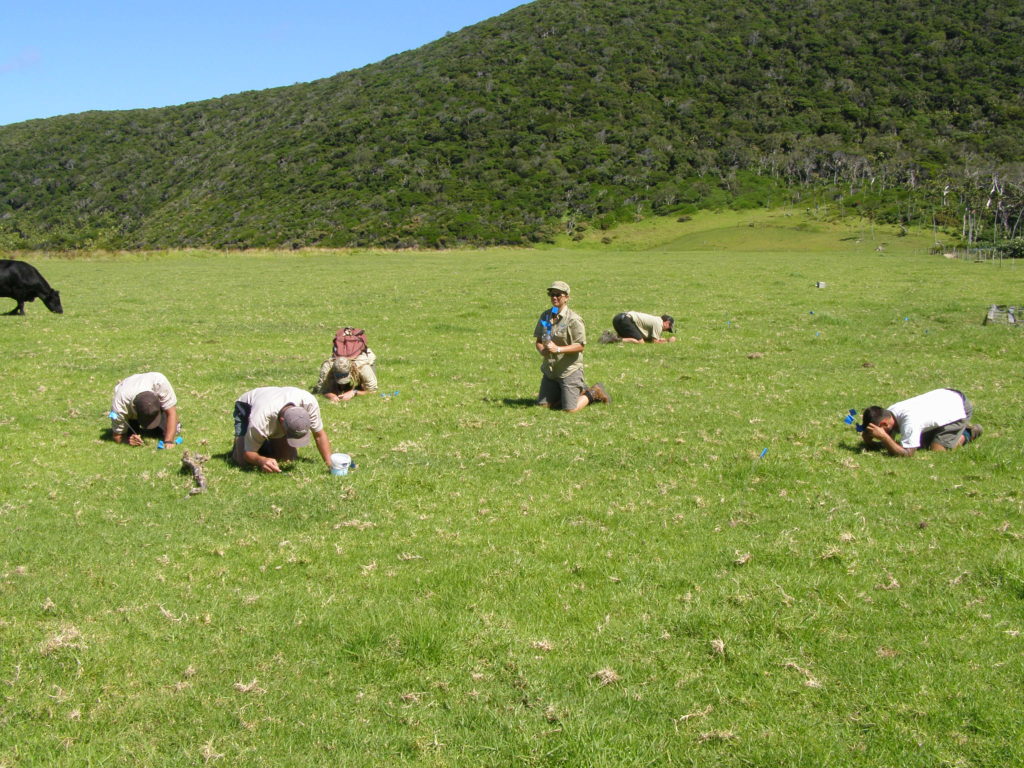Ants. These pesky little creatures can show up with thousands of their family members often as uninvited guests at summertime barbeques and picnics. Attracted to sun and sweets, they can be considered harmless nuisances in the family home and garden.
While there are a number of common ant species found in Australia, invasive or exotic ants are the ones we need to be careful of when it comes to our homes and backyards. Invasive ant species have arrived on our shores due to increasing global trade and can have a major impact on our way of life down under.
A big-headed biosecurity problem

Researchers out in the field looking for the African-big-headed ant on Lord Howe Island
Is this a centre for ants? A team of our scientists and Lord Howe Island residents on the hunt for the African big-headed ant.
Australia has a very delicate but rich natural ecosystem where our native wildlife and vegetation can thrive. Lord Howe Island, just off the east coast of New South Wales, is a prime example of Australia’s biodiversity. The world-heritage listed island contains extraordinary terrestrial and marine ecosystems, beautiful and varied landscapes, and is home to many endangered native animals and plants that can only be found on the island – making it a special place.
In fact, it’s so special that protecting and conserving the island’s ecosystems is really important. It’s rich with trimmings for exotic ants to really thrive.
Which is why when an exotic ant was first detected on the island in 2003, eradication efforts kicked off straight away.
The African big-headed ant is an exotic ant where its head is three times the size of its body. It had spread and taken up residence on the island throughout the settlement area, having a devastating impact on the local landscape. The African big-headed ants are listed as one of the 100 worst pests in the world and can readily out-compete and displace native invertebrates, especially native ants.
On Lord Howe Island, these ants caused damage to native landscapes, built super colonies across the island and caused major damage to buildings.
Our very own Ant Man (and team) to the rescue

Researchers out in the field looking for the African-big-headed ant on Lord Howe Island.
Working hard to find ant infestations on Lord Howe Island.
Trying to track infestations and eradicate ant super colonies requires super human effort because it’s a manually intensive and time consuming process. Precise protocols need to be tested and tweaked to ensure suppression of an exotic species is effective.
Our resident exotic ant-man expert, Dr Ben Hoffman, has dedicated his career to researching the impact of exotic ants on native landscapes all across Australia and the world.
Like the Avengers, it takes a team to fight the good fight and save the world…or in this case, Lord Howe Island. We headed up a team of local rangers and experts to track the African big-headed ant infestations all across the island. They helped set up almost 200,000 lures – which consisted of spoons full of canned pet food – across the island to record the presence of the ant. Once they were able to identify the location of the ants, they were able to use this data and sophisticated mapping technology to then proceed with eradication efforts.
Thanks to the efforts of this team, three years later the African-big-headed ant was declared eradicated from Lord Howe Island.


8th November 2018 at 10:53 am
Also well done team.
I live on the outer rim of the Wombat State forest and I have noted a significant infestation problem with scale on local eucalypt, acacia and other native flora. These appear to be serviced by a very small ant similar to the pictured (can’t confirm the breed – yet) that have created huge colonies of scale ‘farms’ in trees across my property.
While it may also be coincidental, I have seen a significant number of natives across the Wombat forest die by the hectare over the past 20 years. I have tried the several domestic horticultural methods for controlling scale on my plants however the size of the infestation is significant.
I saw the report on the work done in Lord Howe and I am interested in the forms of targeted baiting that the Scientists have for tackling this exotic infestation.
If the CSIRO considers it useful for their work, I would be happy to work with you on this. Please point me to the direction of who I may need to speak with or where I might find real information on this science.
David.
8th November 2018 at 10:49 am
Fipronil (insecticide), methoprene and piriproxyfen (IGR’s) being carpet bombed in SE qld. Fipronil now detectable in Logan River.
Ants not eradicated at this point. Hundreds of millions spent.
8th November 2018 at 10:38 am
What strategy did you use to eliminate this species?
8th November 2018 at 10:09 am
Yes, and conspicuous by its absence of mention! What is happening with the fire ant invasion in southern Queensland?
7th November 2018 at 8:26 pm
Well done team
What about the other invasions of exotic ants in Qld?